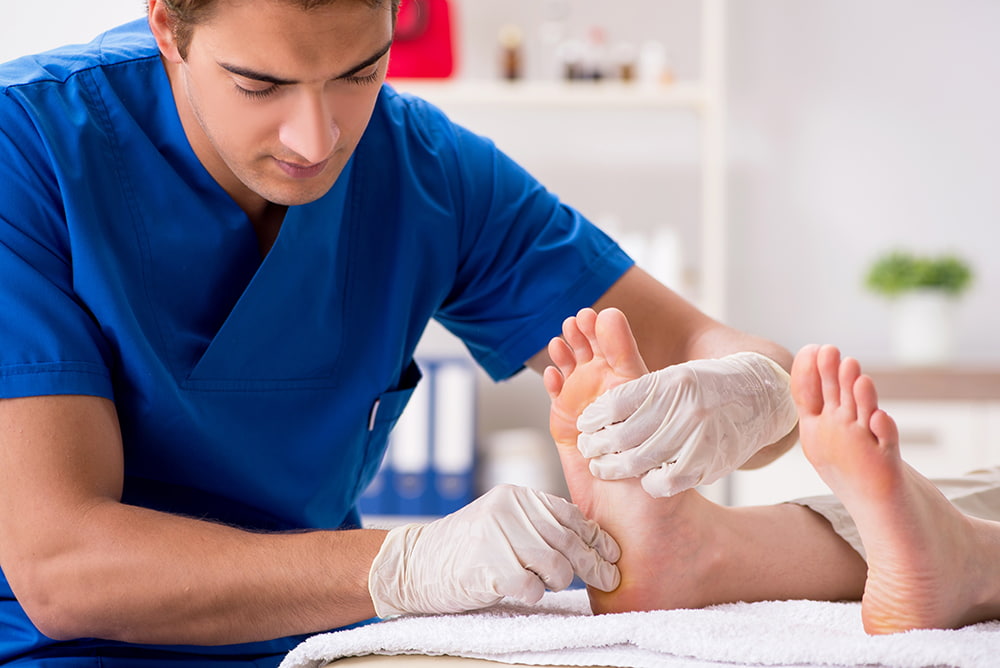In my podiatry practice, it goes without saying, I see a lot of foot issues. But for people with diabetes, foot problems and wounds take on a whole different meaning. Usually they are chronic conditions.
The way you care for your feet can have a big impact on your lifestyle so I thought it might be helpful to share some of the more common misconceptions and myths, as well as good practices, when it comes to foot wound care.
What is the most common foot wound for people with diabetes?
The most common issue I see is the diabetic foot ulcer. This is a break in the skin or a deep sore. Foot ulcers can be caused by minor scrapes, cuts or from the rubbing of shoes that don’t fit properly. It’s important to treat these as soon as you notice them.
Why are people with diabetes at higher risk of foot wounds and wounds that don’t heal?
Most often, people with diabetes are at an increased risk because many suffer from a condition called diabetic peripheral neuropathy. This is when you lose sensation in your feet because of extended periods of elevated blood sugars.
When this happens, you may step on something sharp or on a hot stretch of concrete, or have a rock in your shoe – it could even just be a high pressure point in your shoe. But you won’t notice these things because you can’t feel them. So you’ll continue to walk until the area breaks down and becomes an open sore, or ulcer.
And to make matters worse, having elevated blood sugar levels impede healing. So, it’s an added layer of complication, and that’s why it’s so important to stay on top of foot wounds if you have diabetes.
What are some common myths about wounds and healing?
MYTH #1. Use alcohol or hydrogen peroxide.
While these are good first aid tools for one-time use to disinfect a wound on a skinned knee, they don’t help with long-term wound care or wound healing. In fact, prolonged use of either of these is actually cytotoxic, meaning it kills both unhealthy cells and healthy cells, and slows wound healing.
MYTH #2: Soak a wound.
Soaking an open wound predisposes it to bacteria. On the other hand, showering is great for wounds; it rinses bacteria off and makes it tough for bacteria to stick to the wound.
MYTH #3: Wounds need air to heal.
I think we’ve been told this from our grandparents for generations! What studies actually show is that a moist wound will heal up to five times faster than a dry wound. To provide moisture apply a topical medication then keep it covered with a Band Aid or dressing 24 hours a day.
MYTH #4: Foot wounds need an antibiotic.
The Infectious Disease Society of America recommends that if there is no infection, we don’t need to treat it with antibiotics. Patients with diabetes are already at increased risk of developing antibiotic resistance. So, we only use them if the wound becomes infected.
What about socks and footwear?
If you have a wound on your foot, it is best not to wear shoes. For the wound to heal, you’ll need to remove any pressure to the wound. This may mean using crutches, a wheel chair or a walking boot for a bit. Once healed, it’s critical to be very careful with the shoes and inserts you wear, so there aren’t any pressure areas that may cause the wound to return.
With socks, you should avoid those with seams, because they can rub on your feet or toes and cause issues, too. Your socks also should be made with a breathable fabric that won’t cause excess sweating.
Is it important to examine my feet, and if so how often should I do this?
The American Diabetic Association recommends people with diabetes have their feet checked at least annually by a doctor. If you have diabetic neuropathy, you should check your feet daily.
What are some tips for checking my feet?
It can be hard to see the bottom of our feet, and if you have neuropathy it’s especially difficult to know if anything is wrong because you don’t have feeling in your feet. Here are a couple of ways to check your feet:
- Apply lotion to your feet after bathing or showering. When you run your hands over your feet, you can feel with your hands if there is something new happening with your feet.
- Take a handheld mirror (like you use when you’re checking the back of your hair) and set it on the floor in your bathroom or bedroom. Then hold up your foot so that you can see it in the mirror. This way you can see the bottom of your foot and look for problem areas.
If you see or feel something abnormal with your feet—whether it’s a blister, a cut, a wound or bleeding—call your doctor as soon as possible. This is especially true for those with diabetes and neuropathy.

Jeffrey Wienke, DPM
Dr. Jeffrey Wienke, DPM, is a podiatry specialist at Capital Foot & Ankle.










